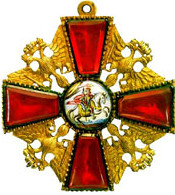
The Order of St. Alexander Nevsky established
“For services and Fatherland”.
The motto of the Order of Saint Alexander Nevsky
On May 21 (June 1), 1725 under Peter’s the Great testament and the supreme order of Catherine I was established one of the highest awards of the Russian Empire – the Order in honor of Saint Lord and Master Grand Duke Alexander Nevsky.
Prince commander Alexander Nevsky had been greatly honored in Russia. He became famous for his victories over Swedes (The Battle of the Neva 1240) and German knights of the Teutonic Order (The Battle of the Ice 1242) In 1724 under the decree of Emperor Peter I the relics of the Saint prince Alexander Nevsky were transported with great care from Vladimir to the new capital of the Russian state – Saint Petersburg, to Alexander Nevsky Lavra. Under the decree of Peter I the day of memory of the saint was set for August 30 (September 10) – the day of conclusion of the victorious Treaty of Nystad with Sweden.
The Order of St. Alexander Nevsky was planned by Peter I as an exclusively military award but the Emperor had not realized his purpose.
The first decorations with the Order were timed for the marriage of Peter’s I and Catherine’s I daughter, Tsarevna Anna Petrovna with Duke Charles Frederick of Holstein-Gottorp.
Among 18 holders of the newly established Russian order were not only military men but also civil ones. Thus the Order of Alexander Nevsky became the order awarded both for battle services and state service.
On the whole during Catherine I reign the Order of Alexander Nevsky had been awarded to 63 people (not counting the Empress herself). In the middle of the 18th century, before the reign of Catherine II, the Order of Alexander Nevsky had been awarded about 300 times. Among its recipients were: Major General P. A. Rumyantsev, who distinguished himself during the Battle of Kunersdorf; General-en-Chef A. P. Hannibal; Lieutenant General V. I. Suvorov who had been the Governor-General of Prussia during the Seven Years’ War; the Academy of Science President K. G. Razumovsky; one of the founders of Moscow University I. I. Shuvalov; enlightener and public figure I. I. Betskoy, etc.
In the reign of Empress Catherine II, over 250 men were awarded the Order of St. Alexander Nevsky. Among them, Major-General A. V. Suvorov, Infantry General M. I. Kutuzov, Vice-Admiral F. F. Ushakov and de Ribas, Privy Councillor, a well-known historian and collector of ancient manuscripts – A. I. Musin-Pushkin.
Under Paul I the Order of St. Alexander Nevsky was awarded to 80 men. The high award was given to state and public figure, Admiral, President of the Russian Academy of Sciences, Minister of Education A. S. Shishkov.
The Order statute was published on April 5 (160, 1797. Beginning from that year the Order started to be decorated with diamonds which represented its high class. Such orders were awarded not only to Russians but also to foreign subjects. The statute set no limits for the number of holders.
The Order’s cross was covered with red enamel from front and reverse. In the middle of the cross, on the front, was the image of Saint Alexander Nevsky on the horse; between the ends of the cross were double-headed eagles under the imperial crown. The silver eight-point star of the Order had in its center a rosette with ‘SA’ monogram under the princely crown. Around the Order’s circumference, on the red background in golden letters was written the devise: ‘For services and Fatherland’.
From 1844, when the Order was granted to those of non-Christian religion, instead of the image of Alexander Nevsky and his monogram, the decoration bore the image of the Russian imperial eagle. From 1855 to the Order decoration were added two crossed swords.
The Order’s cross was worn on red watered ribbon put on over the left shoulder; the star was worn of the left side of the chest.
The Order of Alexander Nevsky was abolished as a state award in 1917.
During the Great Patriotic War, in 1942, was established the Soviet Order of Alexander Nevsky awarded to all kinds of commanders, from platoons to divisions inclusive, who had demonstrated courage and contributed to successful actions of their units.
Lit.: Дуров В. А. Русские награды XVIII – начала XX в. М., 1997; Императорский орден Святого Благоверного Великого Князя Александра Невского [Электронный ресурс] // Ордена и медали России. 2006-2013. URL: http://www.rusorden.ru/?nr=ri&nt=4; Орден Св. Александра Невского [Электронный ресурс] // За веру и верность. 2000. URL: http://award.armor.kiev.ua/nevsky/index.html; Симонов А. А., Закатов А. Н. Императорские Ордена России (1698-1997). М., 1997; Шишков C. С. Награды России. 1698–1917 гг. 2003. Т. 1.
Based on the Presidential Library’s materials:

